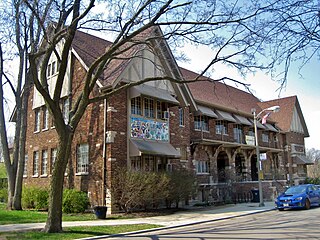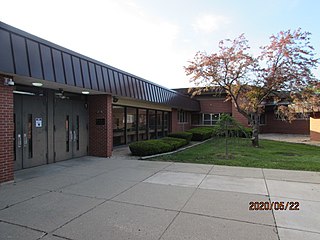
Arlington Heights is a village in Cook County in the U.S. state of Illinois. A northwestern suburb of Chicago, it lies about 25 miles (40 km) northwest of the city's downtown. As of the 2020 census, the village's population was 77,676, making it the 15th-most-populous municipality in Illinois.

Morton Grove is a village in Cook County, Illinois. Per the 2020 census, the population was 25,297.

Niles is a village in Cook County, Illinois, United States, located in the townships of Maine and Niles, directly neighboring the City of Chicago's far northwest border. Per the 2020 census, the population was 30,912. The current mayor of Niles is George Alpogianis.

Skokie is a village in Cook County, Illinois, United States, neighboring the City of Chicago's northern border. Skokie's population, according to the 2020 census, is 67,824. Skokie lies approximately 15 miles (24 km) north of Chicago's downtown Loop. The name Skokie comes from a Potawatomi word for "marsh". For many years, Skokie promoted itself as "The World's Largest Village". Skokie's streets, like that of many suburbs, are largely a continuation of the Chicago street grid, and the village is served by the Chicago Transit Authority, further cementing its connection to the city.

Albany Park is one of 77 well-defined community areas of Chicago. Located on the Northwest Side of the City of Chicago with the North Branch of the Chicago River forming its east and north boundaries, it includes the ethnically diverse Albany Park neighborhood, with one of the highest percentages of foreign-born residents of any Chicago neighborhood.

The North Shore consists of suburbs north of Chicago, Illinois, that border Lake Michigan. These communities form part of Cook and Lake Counties. Deerfield, Evanston, Fort Sheridan, Glencoe, Glenview, Highland Park, Highwood, Kenilworth, Lake Bluff, Lake Forest, Northbrook, Northfield, Skokie, Wilmette and Winnetka make up the North Shore.

Area codes 847 and 224 are telephone area codes in the North American Numbering Plan (NANP) for the U.S. state of Illinois. The numbering plan area (NPA) comprises the northeastern part of Illinois and many northern suburbs of Chicago. This includes most of Lake County, the northern part of Cook County, the northern part of Kane County, and a small part of McHenry County.

Niles North High School, officially Niles Township High School North, is a public four-year high school located in Skokie, Illinois, a North Shore suburb of Chicago, Illinois in the United States. It is part of Niles Township Community High School District 219, which also includes Niles West High School. Its feeder middle schools are Old Orchard Junior High, Oliver McCracken Middle School, East Prairie School, and Golf Middle School. Before being moved to a separate facility in Lincolnwood, Illinois, the school hosted the Bridges Adult Transition program.
Nisei is a Japanese-language term used in countries in North America and South America to specify the ethnically Japanese children born in the new country to Japanese-born immigrants. The Nisei are considered the second generation, and the grandchildren of the Japanese-born immigrants are called Sansei, or third generation.

Japanese Americans are Americans of Japanese ancestry. Japanese Americans were among the three largest Asian American ethnic communities during the 20th century; but, according to the 2000 census, they have declined in number to constitute the sixth largest Asian American group at around 1,469,637, including those of partial ancestry.
The Chicago Shimpo, published by Chicago Shimpo, Inc., is a Japanese-American newspaper published for readers in the Chicago, Illinois area. As of 1995 it was published twice weekly. It is currently headquartered in Arlington Heights, Illinois, and its offices were previously located in Albany Park, Chicago. The Chicago Shimpo, which publishes articles in Japanese and English, is the only Japanese-American newspaper in the Chicago media market.

Chicago Futabakai Japanese School, alternately in Japanese Shikago Nihonjin Gakkō, is a Japanese elementary and junior high day school and Saturday education program in Arlington Heights, Illinois near Chicago. As of 1988 it is sponsored by the Japanese Ministry of Education, now the Ministry of Education, Culture, Sports, Science and Technology (MEXT). Before moving to Arlington Heights in 1998, the Futabakai education program was previously located in Chicago, Skokie, and Niles in Illinois, with the day program beginning during the period in Skokie.
The mix of ethnic groups in Chicago has varied over the history of the city, resulting in a diverse community in the twenty-first century. The changes in the ethnicity of the population have reflected the history and mass America, as well as internal demographic changes. The groups have been important in the development of the city as well as players in occasional conflicts.
Calvin Sutker was an American politician and lawyer. Over his nearly four decades in politics, Sutker served as a Skokie Village Board member, Niles Township Democratic Committeeman, Democratic National Committeeman from Illinois, Chairman of the Illinois Democratic Party, a member of the Illinois House of Representatives and a Cook County Commissioner.
As of the 2000 U.S. Census there were 45,000 South Korean-origin people in the Chicago metropolitan area. As of 2006 the largest groups of Koreans are in Albany Park, North Park, West Ridge, and other communities near Albany Park. By that time many Koreans began moving to northern and northwestern Chicago suburbs, settling in Glenview, Morton Grove, Mount Prospect, Niles, Northbrook, Schaumburg, and Skokie. A Koreatown, labeled "Seoul Drive", exists along Lawrence Avenue between Kedzie Avenue and Pulaski Road. There were a number of Korean businesses on Clark Street in the 1970s, in Lakeview and Lincoln Park.
At the end of the 20th century there were a total of 270,000 Jews in the Chicago area, with 30% in the city limits. In 1995, over 80% of the suburban Jewish population lived in the northern and northwestern suburbs of Chicago. At this time, West Rogers Park was the largest Jewish community within the city of Chicago. However, the Jewish population within the city had been declining and tended to be older and more well-educated than the Chicago average. The Jewish immigrants to Chicago came from many different countries, with the most common being Eastern Europe and Germany.
Eugenia Sheldon Chapman was an American educator and politician.

Esther Takei Nishio was an American woman from California, incarcerated at the Granada War Relocation Center in Colorado during World War II. She was the first Japanese-American student to enroll in a California university after returning from camp, in 1944, when she was chosen as a test case for resettlement.
Louise Suski was the first woman editor-in-chief and English-section editor-in-chief at the Japanese-English language newspaper Rafu Shimpo.












